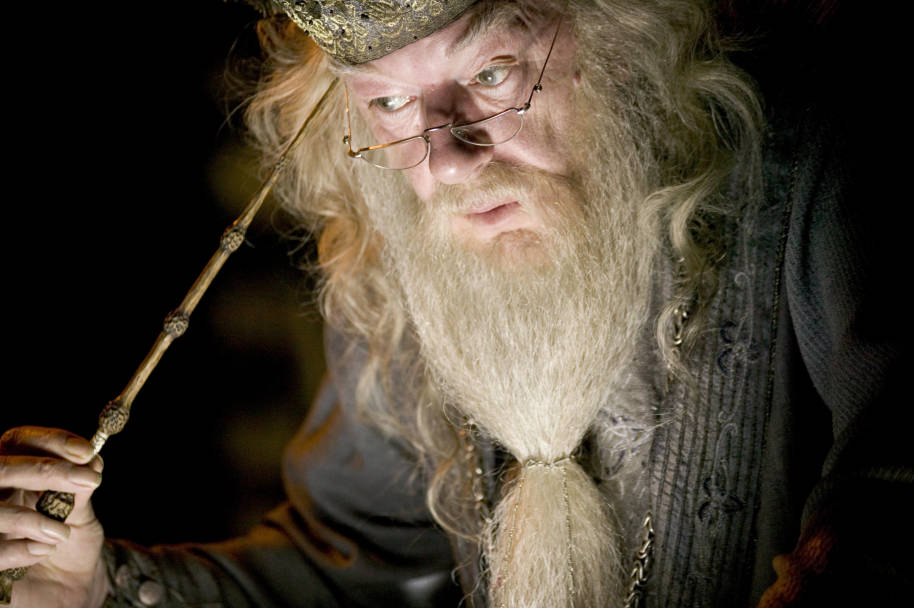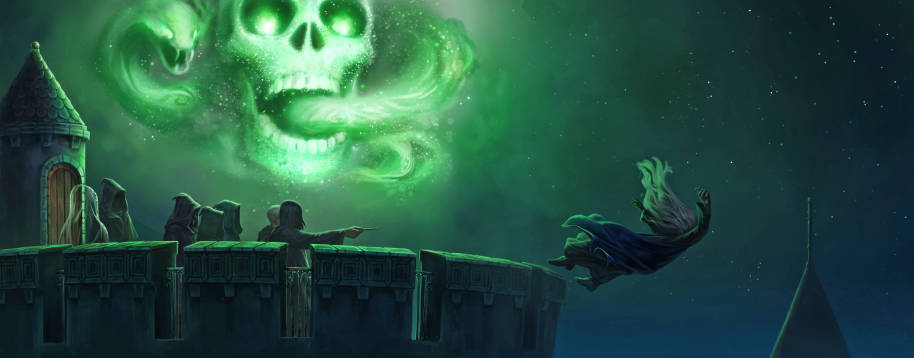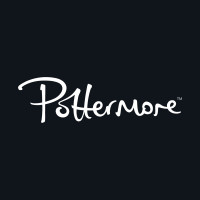
It was probably first used by Antioch Peverell
In the wizard fable ‘The Tale of the Three Brothers', the eldest brother was gifted a powerful wand created by Death himself. In the end, he was murdered for his seemingly unbeatable wand.
In Harry Potter and the Deathly Hallows, it became apparent that the Elder Wand, along with the Resurrection Stone and Invisibility Cloak, were very real objects in the wizarding world. Xenophilius Lovegood's claim that the Peverell brothers – Antioch, Cadmus and Ignotus – were their original owners was supported by Albus Dumbledore’s theory that they were also the inventors. As the oldest Peverell brother, Antioch was the one associated with the Elder Wand.
It goes by many names
The Elder Wand has also been known as the ‘Wand of Destiny’, a title evocative of the grandeur and power that has enticed so many wizards. Other names have been bestowed upon it through the years. Some were derived from simple translations, such as the ‘Eldrun Wand’, which was the name given by Barnabas Deverill (‘eldrun’ and ‘ellhorn’ both being archaic terms for ‘elder’). It was also dubbed the ‘Deathstick’ by Loxias, who ensured that the instrument lived up to its title, and the Dark wizard Godelot called it ‘My most wicked and subtle friend, with body of Ellhorn, who knowes ways of magick moste evile.’ It didn’t catch on.

Its design is unusual in almost every respect
Virtually every detail of the Elder Wand hints at something unique or exceptional by a wandmaker’s standards.
Elder wood is not a favoured material in wand-making. However, it is still included in Garrick Ollivander’s notes:
Only a highly unusual person will find their perfect match in elder, and on the rare occasion when such a pairing occurs, I take it as certain that the witch or wizard in question is marked out for a special destiny.
Wand Woods: Writing by J.K. Rowling
Stranger still, the Elder Wand’s core substance is Thestral hair. There are no Ollivander notes to go by – it wasn’t a material he chose to work with – but we do know that Thestrals have a strong connection with death, plus the magical properties of invisibility, flight and an uncanny ability to find their destination. How this affects the wand is uncertain, but it does hint towards some seriously powerful magic.

It has a long and bloody history
Unlike the Resurrection Stone and Invisibility Cloak, which were handed down through the Gaunt and Potter family lines respectively, the Elder Wand was repeatedly seized by power-hungry wizards. In the words of Xenophilius Lovegood: ‘The bloody trail of the Elder Wand is splattered across the pages of wizarding history.’
Egbert the Egregious was said to have slaughtered Emeric the Evil to win ownership. Over a century later, Godelot, who had the wand in his possession while writing Magick Moste Evile, perished after being locked in the cellar by his own son Hereward. Loxias ended the reign of the fearsome warlock Barnabas Deverill, only to be defeated himself by an unknown person (two possible contenders were Arcus and Livius) who presumably took the wand for their own. In the twentieth century, the wizards Gregorovitch, Gellert Grindelwald and Severus Snape were all slaughtered in Lord Voldemort’s pursuit of the Elder Wand.
As Dumbledore stated in Tales of Beedle the Bard, ‘Those who are knowledgeable about wandlore will agree that wands do indeed absorb the expertise of those who use them.’ With the volume of dark deeds attributed to the Elder Wand, that is a terrifying thought.
Only men have claimed ownership, as far as we know
All wizards who boasted of winning the Elder Wand had something in common – they were, quite specifically, wizards. However, this may not tell us the full story. Tempting as it may be, one can own the Elder Wand without bragging about it. Indeed, it would be prudent to resist, given the wand’s tendency to attract would-be murderers. It is also possible to acquire the Elder Wand without even realising, as in the case of Draco Malfoy.

Could a witch have owned the Elder Wand at some point? It’s possible, especially if she did so stealthily, unknowingly or if it simply went undocumented for whatever reason. After all, entire centuries of the wand’s history remain unaccounted for. One witch even claimed to have killed the wand’s then-master (namely Loxias; the claim was made by his own mother). And what about Tina Goldstein in Fantastic Beasts and Where to Find Them? We saw her disarming Grindelwald. If Grindelwald had the Elder Wand at this point – did this make her the master?
Dumbledore’s words on the subject are open to interpretation: ‘No witch has ever claimed to own the Elder Wand. Make of that what you will.’
There have been several misconceptions surrounding its ownership
Perhaps the most famous fallacy surrounding the Elder Wand is the supposition that the prospective owner must kill the current one. This came at a cost for Lord Voldemort, who falsely assumed that murdering Severus Snape was the key to the wand’s control. Though killing has been a popular method of claiming the wand (see the ‘long and bloody history’ section for examples), it is by no means the only way.
We know the Elder Wand allied with Draco Malfoy, who disarmed rather than killed Albus Dumbledore. It later switched its loyalty to Harry Potter during his escape from Malfoy Manor. While deaths did occur in both situations (Dumbledore and Dobby respectively), neither Draco nor Harry committed the act. Similarly, Albus Dumbledore managed to control the Elder Wand without killing its previous master who, in fact, outlived him.

However, the belief that the Elder Wand will automatically switch allegiance whenever the owner is disarmed is also false, for one very important reason...
The Elder Wand decides its own destiny
Mr Ollivander’s famous statement ‘the wand chooses the wizard’ rings just as true for the Elder Wand as any other. However, according to J.K. Rowling, there are some distinct tendencies in its manner of choosing: ‘The Elder Wand knows no loyalty except to strength. So it’s completely unsentimental. It will only go where the power is.’
Though any wand can potentially switch allegiance, most hold some degree of loyalty and attachment to their masters. By contrast, the Elder Wand is ‘dispassionate and ruthless’ in its need for power, forming no true bond with the wielder.
We know the Elder Wand is drawn to power. But what does this ‘power’ actually entail?
‘The emotional state of wizards where a lot hangs on a duel, that’s something different. That’s about real power and that’s about transference that will have far-reaching effects in some cases.’
J.K. Rowling, Pottercast interview, 2007
With that in mind, consider the Elder Wand’s decisions in the final two books. The stand-off between Draco and Dumbledore was fraught with emotion – Dumbledore knew he was about to die while Draco raged an internal war with his own morality. At Malfoy Manor, Draco was once again conflicted while Harry was determined to escape and finish his quest. In both scenes, emotions ran high and everything was at stake. It was enough to affect the Elder Wand, even when it was not present at the scene.
But what caused the Elder Wand to turn from Grindelwald to Dumbledore? That’s something we’d all like to know.
To find out more about the life of Gellert Grindelwald, click here.


